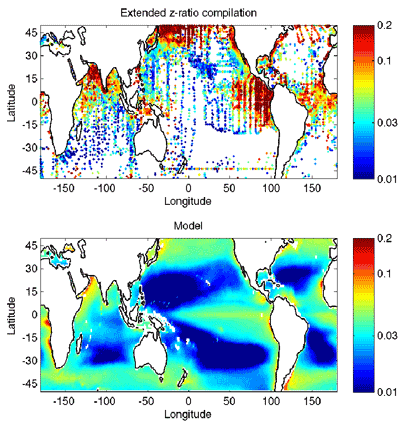NOAA scientists develop simple model to predict global patterns in the energy available to marine resources
Stock, Charles A., and John P. Dunne. Deep-Sea Research, Part I – 57(1), doi:10.1016/j.dsr.2009.10.006.
On November 24, 2009 scientists from NOAA’s Geophysical Fluid Dynamics Laboratory (GFDL) published a study on global patterns in the transfer of energy from phytoplankton to mesozooplankton. The production of organic matter from light and nutrients by phytoplankton, referred to as primary production, supports nearly all ocean life. Mesozooplankton consume phytoplankton and smaller zooplankton and act as a conduit within the marine food web for primary production to reach critical living marine resource (e.g., harvested fish and endangered species). The study combined a marine ecosystem model with a broad synthesis of published in-situ, laboratory, and satellite data to reveal and explain global-scale relationships between primary production and mesozooplankton production.

Figure: The top-panel shows global estimates of the ratio of mesozooplankton production to primary production (referred to as the z-ratio) estimated from a combination of in-situ and laboratory mesozooplankton data, and satellite-derived primary production. Critical zooplankton biomass data for this compilation was provided by NOAA’s global plankton database “COPEPOD”. The bottom panel shows model-derived z-ratios. Both the estimates in the top panel and the model-derived estimates have uncertainties and the observed zooplankton biomass can be highly patchy. However, the critical similarity is the order-of-magnitude shift between unproductive sub-tropical gyres (large blue patches), and highly productive regions near the coast and in upwelling regions along the equator.
It was found that, on average, only 1-4% of primary production by phytoplankton is translated to mesozooplankton production in relatively unproductive marine ecosystems such as sub-tropical gyres. This compares with 10-20% in highly productive marine ecosystems such as coastal upwelling systems (see figure). An important implication of this finding is that climate-driven fractional changes in primary production may yield larger fractional changes in mesozooplankton production. Since mesozooplankton are important food items for fish, these changes may also have pronounced impacts on fisheries production.
The simple model developed in this study represents a first step in directly linking climate models of the physical climate system to models that predict long term changes in fish stocks resulting from climate change. The simple model is presently being integrated into GFDL’s Earth System Model, where it will provide a means of predicting the impacts of climate variability and change on the energy available to marine resources.
Reference
Stock, Charles A., and John P Dunne, January 2010: Controls on the ratio of mesozooplankton production to primary production in marine ecosystems. Deep-Sea Research, Part I, 57(1), doi:10.1016/j.dsr.2009.10.006.
Click here to access the manuscript that is in press.
Click here to return to my home page.


